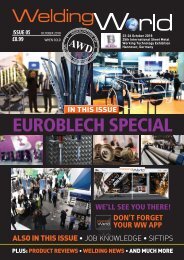Welding World Magazin April 2018
Create successful ePaper yourself
Turn your PDF publications into a flip-book with our unique Google optimized e-Paper software.
16<br />
NEWS<br />
POWER TOOL INVENTOR<br />
Part 1 of 2<br />
TALKS MAG DRILLS<br />
Nathan Ford, Area Sales Manager for Fein<br />
Power Tools in the UK, discusses what you<br />
should look for when purchasing a mag<br />
drill and the applications some can now<br />
achieve. He will also briefly cover the new<br />
cordless/compact mag drills new into the<br />
UK market.<br />
Magnetic core drills or “Magdrills”<br />
for short are an essential tool for<br />
anyone involved in the production and<br />
installation of structural steel. They<br />
can also be a handy addition to the<br />
tool kit of anybody looking to drill<br />
larger diameter holes. Core drilling is<br />
an extremely efficient process which is<br />
faster, quieter and more accurate than<br />
twist drilling. Core drilling requires no<br />
predrilling or switching over of the<br />
tooling, and so drilling times can be<br />
reduced by over 50%, with minimal<br />
physical effort by the user.<br />
CHOOSING YOUR DRILL<br />
The first decisions to be made when<br />
buying a Magdrill is the capacity of the<br />
machine and what size hole are you<br />
likely to be drilling? Next, consider what<br />
thickness material you will be drilling?<br />
An obvious question yet if you are<br />
buying a drill with a 30mm max capacity<br />
and on your next job you need to drill a<br />
35mm hole it may have been worthwhile<br />
buying the model up from the original<br />
machine. Fein currently offers a large<br />
range of Magdrills from 30-80mm<br />
capacity, the new cordless Magdrill<br />
starting at 35mm.<br />
When it comes to depth of cut, most<br />
machines will be able to handle a<br />
cutter with a depth of 25mm. For most<br />
applications this will suffice but if you<br />
have an application which requires either<br />
the cutting of thicker material, or the<br />
drilling of box sections, or step drilling, it<br />
is worth looking for a drill with as large<br />
a stroke range as possible. Ranges can<br />
vary from 65mm to 315mm so it worth<br />
taking this into consideration.<br />
APPLICATIONS<br />
What is the machine going to be<br />
used for? You just want to drill a hole<br />
into a piece of steel, right? You have<br />
chosen your drill based on the size of<br />
hole and material thickness, but there<br />
may be some other criterias to look<br />
at. Most Magdrills are fixed speed and<br />
manufactured so in order to keep costs<br />
down; designed to drill a hole into<br />
steel. Fein invests more into most of its<br />
mag drills allowing the motor to deliver<br />
variable speed (except the KBB range).<br />
This variable speed, and in addition<br />
reverse functions are important if you<br />
have varying diameter holes to drill or<br />
are looking for a Magdrill which can tap,<br />
ream or countersink.<br />
There are many standard providers of<br />
mag drill in the market and Fein itself<br />
offers Economical models. Its premium<br />
models offer variable speeds and the<br />
programmes discussed (universal), or<br />
automated drill feeds (automatic). Fein<br />
was proud to launch two new classes<br />
of mag drill in late 2017, ‘Cordless’ and<br />
‘Compact’. The brand new AKBU 35<br />
(cordless) helps end-users who lack mains<br />
power on-site or who need to work at<br />
heights. If working in confined spaces a<br />
specialist right angled Magdrill would be<br />
needed, with a minimum head clearance<br />
of 169mm. The new ‘compact’ KBC 35<br />
would assist, small enough to help get<br />
into tight spots.<br />
Find out more about Fein’s mag drill<br />
range including these new machines:<br />
https://fein.com/en_uk/drilling/metalcore-drilling/<br />
WELDING WORLD MAGAZINE | ISSUE 02 | APRIL <strong>2018</strong>
















